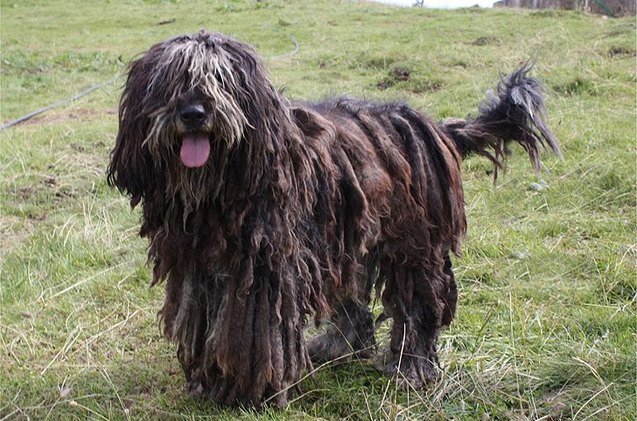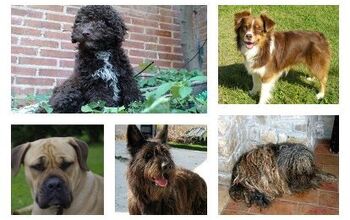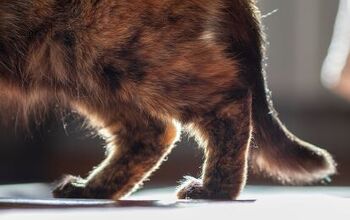Bergamasco


About Bergamasco
The Bergamasco Sheepdog looks more like a dreadlocked Rasta than anything else. It is one of the most ancient breeds of sheepdogs and has a history stretching back nearly 2000 years. The Bergamasco’s body is square-shaped and compact; this gives this dog a perfect harmony between speed, agility and strength. This strong-boned and well-muscled dog is capable of running long distances for fairly long period of time.
The Bergamasco Sheepdog is often described as strong, sound and brave; qualities that are essential in a herding breed. They are highly intelligent and capable of thinking independently, and are very easy to train with positive reinforcement. These dogs are still used in many regions in Europe as herders. They also make excellent competitors for dog agility trials, obedience, flyball, tracking, showmanship and herding events. Many Bergamascos have also found homes as guard dogs and companion dogs.
The Bergamasco Sheepdog looks more like a dreadlocked Rasta than anything else.
Bergamascos are an ancient breed with a history of over 2000 years. It is believed that they originated from the ancient sheepdogs used in Persia. The Persian shepherds that migrated eastwards ultimately settled in the valley of Bergamo in the Italian Alps, hence the breed’s name. The breed has remained relatively unchanged since then.
Bergamasco Sheepdog populations reached all-time lows at the close of World War II as demand for wool and sheepdogs declined. It took the dedicated efforts of an Italian breeder named Dr. Maria Andreoli to save and revive the breed during the 1960s. The first Bergamscos were introduced to the United States around 1990 and they still remain a relatively rare breed.
It is believed that much of the Bergamasco’s pedigree is attributed to the ancient long-coated dogs used by the very first shepherds in the Zagros Mountains. Much of the Bergamasco’s characteristics are those of its ancient ancestors and remain unchanged, with certain traits introduced to the breed by environmental and historical changes.
Bergamasco Sheepdogs can be fed on a varied diet of kibble and high quality raw/canned foods. They should be fed twice a day, once in the morning and again in the evening. Puppies, however, can be fed three times a day.
Bergamascos are an extremely intelligent breed of dog and are capable of independent thought and action.
Bergamascos are an extremely intelligent breed of dog and are capable of independent thought and action. This makes them extremely receptive to positive reinforcement based training techniques. In ancient times, when Bergamascos were tasked with guarding large flocks of sheep or cattle with little supervision, it was imperative that they be able to think for themselves and make quick decisions. However, this also means that when faced with a lack of leadership, they can be willful and stubborn. Therefore it is important to provide them with assertive and consistent leadership.
The ideal weight for a full-grown Bergamasco male ranges from 70 to 84 pounds.
Bergamascos are generally a peaceful and well-balanced breed of dog. However, they do require rules, boundaries and limitations in addition to love and attention in order to lead a healthy life. Faced with a lack of leadership, they can sometimes view themselves as equals in a human pack as opposed to subordinates.
Although not an aggressive breed, Bergamascos do make good guard dogs because they are naturally suspicious of strangers. However, they will not attack unless they feel that their family is directly under threat.
Bergamascos are extremely caring and playful with children and have even been used in therapy work with disabled children. The presence of children seems to awaken their natural guarding and herding instincts. They also get along well with other dogs and animals, provided that they are socialized well from an early age.
Bergamasco Sheepdogs are generally a very healthy breed and do not suffer from any hereditary health problems.
A well cared for Bergamasco will enjoy a healthy lifespan of around 10-15 years.
As a working breed of dog, Bergamascos require a great deal of exercise and are unsuitable for owners that aren’t physically active. They thrive when raised in large farms or vast properties where they can run about freely and exercise by themselves. As a highly intelligent and independent breed, they also require ‘meaningful’ tasks with which to occupy themselves with.
Bergamascos are generally a peaceful and well-balanced breed of dog.
The AKC has this to say about the Bergamasco Sheepdog: “A sheepdog with a strong work ethic, the Bergamasco’s most unique characteristic is its coat, which contains “dog hair,” “goat hair” and “wool” that combine to form black or gray felt-like mats. The mats grow over the course of the dog’s life, reaching the ground at approximately 6 years of age. The coat can actually smell like a sweater when it is wet. But despite its formidable appearance, the Bergamasco is really a trim, athletic sheepdog.” The Bergamasco was first recognized by the AKC in 1997.
The Bergamasco’s coat is made up of three distinctive layers. The undercoat is fine, dense and oily, and forms a waterproof layer. The second layer is long and wiry like that of a goat’s. The third layer is wooly and entwines with the second layer to form the Bergamasco’s distinctive dreadlock-like coat. And despite their ragged appearance, these dogs do not require much grooming; two to three baths a year and occasional brushing is more than adequate to keep the coat in good health.
Bergamasco puppies are highly energetic and playful. They should be socialized with humans and other animals at a very young age.
Photo credit: Luigi Guidobono Cavalchini/ Wikimedia; CT M/ Flickr; David McKelvey/ Flickr

Amy Tokic, Editor of PetGuide.com, is a passionate animal lover and proud pet parent of Oscar, a Shih Tzu/Chihuahua cross, and Zed, a Japanese Chin. Her love of animals began in kindergarten, when she brought her stuffed dog Snoopy into class with her every day. Now, she writes about her adventures in pet ownership and tirelessly researches products, news and health related issues she can share with other animal enthusiasts. In her free time, Amy loves perusing used book and record stores, obsessing over the latest pet products available and chasing squirrels with wild abandon (a habit attributed to spending too much time with her pooches).
More by Amy Tokic

























